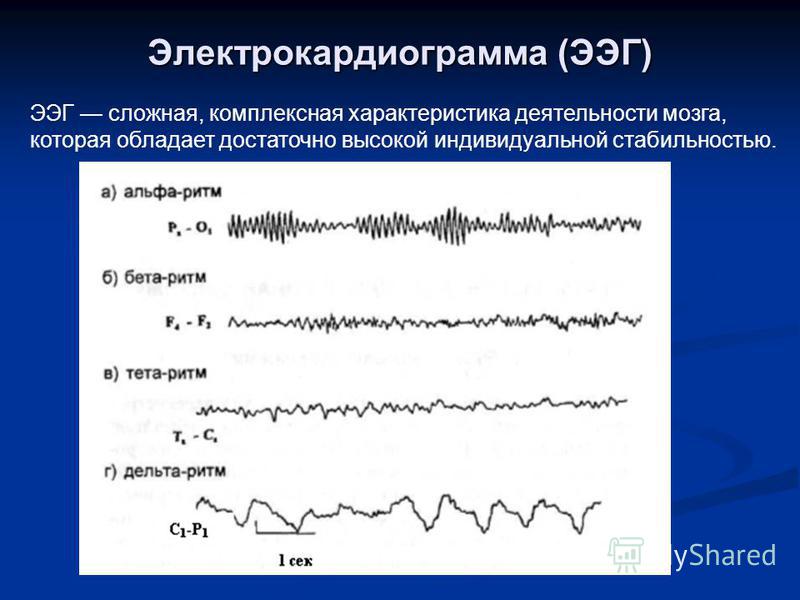Full form eeg. Electroencephalogram (EEG): A Comprehensive Guide to Brain Activity Recording
What is an electroencephalogram. How is an EEG performed. Why are EEGs used. What types of EEGs are available. How should you prepare for an EEG. What can EEGs diagnose. How long does an EEG take.
Understanding the Electroencephalogram (EEG): A Window into Brain Activity
An electroencephalogram, commonly known as an EEG, is a sophisticated medical test that records electrical activity in the brain. This non-invasive procedure provides valuable insights into brain function and has become an indispensable tool in neurology and psychiatry.
During an EEG, small sensors called electrodes are attached to the scalp using a special adhesive. These sensors detect the tiny electrical impulses generated by brain cells as they communicate with each other. The signals are then amplified and recorded by a machine, producing a detailed map of brain activity that can be analyzed by medical professionals.
How does an EEG work?
The human brain consists of billions of neurons that constantly exchange electrical signals. An EEG captures these signals and translates them into wave patterns. Different types of brain waves correspond to various states of consciousness and brain activity. For example:

- Delta waves: Associated with deep sleep
- Theta waves: Linked to drowsiness and light sleep
- Alpha waves: Present during relaxed wakefulness
- Beta waves: Indicative of active thinking and concentration
- Gamma waves: Related to higher cognitive functions and information processing
By analyzing these wave patterns, doctors can gain valuable insights into brain function and identify potential abnormalities or disorders.
The Diverse Applications of EEG in Medical Diagnosis
EEGs serve a wide range of diagnostic purposes in modern medicine. Their primary use is in the diagnosis and management of epilepsy, a neurological disorder characterized by recurrent seizures. However, the applications of EEG extend far beyond epilepsy.
What conditions can an EEG help diagnose?
EEGs are instrumental in investigating various neurological and psychiatric conditions, including:
- Epilepsy and seizure disorders
- Sleep disorders such as narcolepsy and sleep apnea
- Brain tumors
- Encephalitis (inflammation of the brain)
- Stroke
- Dementia and Alzheimer’s disease
- Head injuries and concussions
- Attention deficit hyperactivity disorder (ADHD)
- Autism spectrum disorders
- Certain psychiatric conditions
In addition to diagnosis, EEGs can also be used to monitor the effectiveness of treatments and track the progression of certain neurological conditions over time.
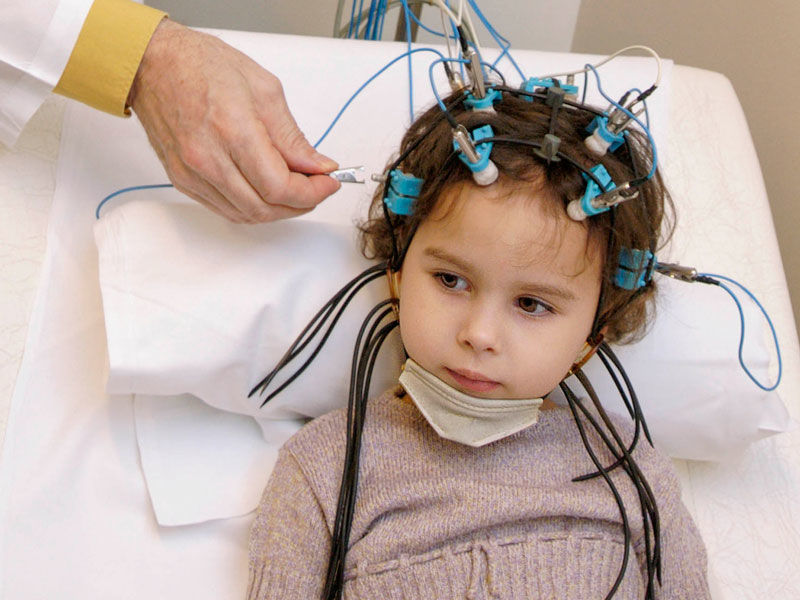
The EEG Procedure: What to Expect During Your Test
Undergoing an EEG is generally a straightforward and painless process. The procedure is typically carried out by a trained specialist called a clinical neurophysiologist in a hospital or specialized clinic setting.
How is an EEG performed?
The EEG procedure typically involves the following steps:
- Preparation: Your scalp will be cleaned, and approximately 20 small electrodes will be attached using a special adhesive.
- Connection: The electrodes are connected to the EEG recording machine via wires.
- Recording: You’ll be asked to sit or lie down comfortably while the machine records your brain activity.
- Stimuli: During the test, you may be asked to perform simple tasks such as opening and closing your eyes, breathing deeply, or looking at a flashing light.
- Duration: A routine EEG usually takes 20 to 40 minutes, although the entire appointment may last about an hour.
- Completion: Once the recording is finished, the electrodes are removed, and you’re free to go about your day.
It’s important to note that EEGs are non-invasive and do not involve any radiation exposure, making them safe for patients of all ages, including infants and pregnant women.

Preparing for Your EEG: Ensuring Optimal Results
Proper preparation can help ensure the accuracy and effectiveness of your EEG test. While specific instructions may vary depending on the type of EEG and the medical facility, there are some general guidelines to follow.
How should you prepare for an EEG?
To prepare for your EEG:
- Wash your hair the night before or the morning of the test, but avoid using any hair products like gels, sprays, or oils.
- Eat normally and take your regular medications unless instructed otherwise by your doctor.
- Avoid caffeine and other stimulants for at least 8 hours before the test, as they can affect brain activity.
- Get a good night’s sleep before the test, unless you’re scheduled for a sleep-deprived EEG.
- Wear comfortable clothing that’s easy to remove or adjust, as you may need to change into a hospital gown.
- Bring a list of all medications you’re currently taking, including over-the-counter drugs and supplements.
If you have any questions or concerns about preparing for your EEG, don’t hesitate to contact your healthcare provider for clarification.

Types of EEG: Tailoring the Test to Specific Needs
Different types of EEG tests are available to suit various diagnostic requirements and patient needs. Understanding these options can help you better prepare for your upcoming test.
What are the main types of EEG tests?
The most common types of EEG tests include:
- Routine EEG: This standard test lasts 20-40 minutes and is performed while you’re awake.
- Sleep EEG: Conducted while you’re asleep, this test can provide additional information about brain activity during different sleep stages.
- Sleep-deprived EEG: You may be asked to stay awake the night before this test to induce sleep during the recording.
- Ambulatory EEG: This involves wearing a portable EEG recorder for 24 hours or more to capture brain activity during daily activities.
- Video EEG: Combines EEG recording with video monitoring, often used to evaluate seizures.
- Intensive monitoring EEG: A long-term test conducted in a hospital setting, typically for patients with difficult-to-diagnose seizures.
Your doctor will determine which type of EEG is most appropriate based on your symptoms and medical history.
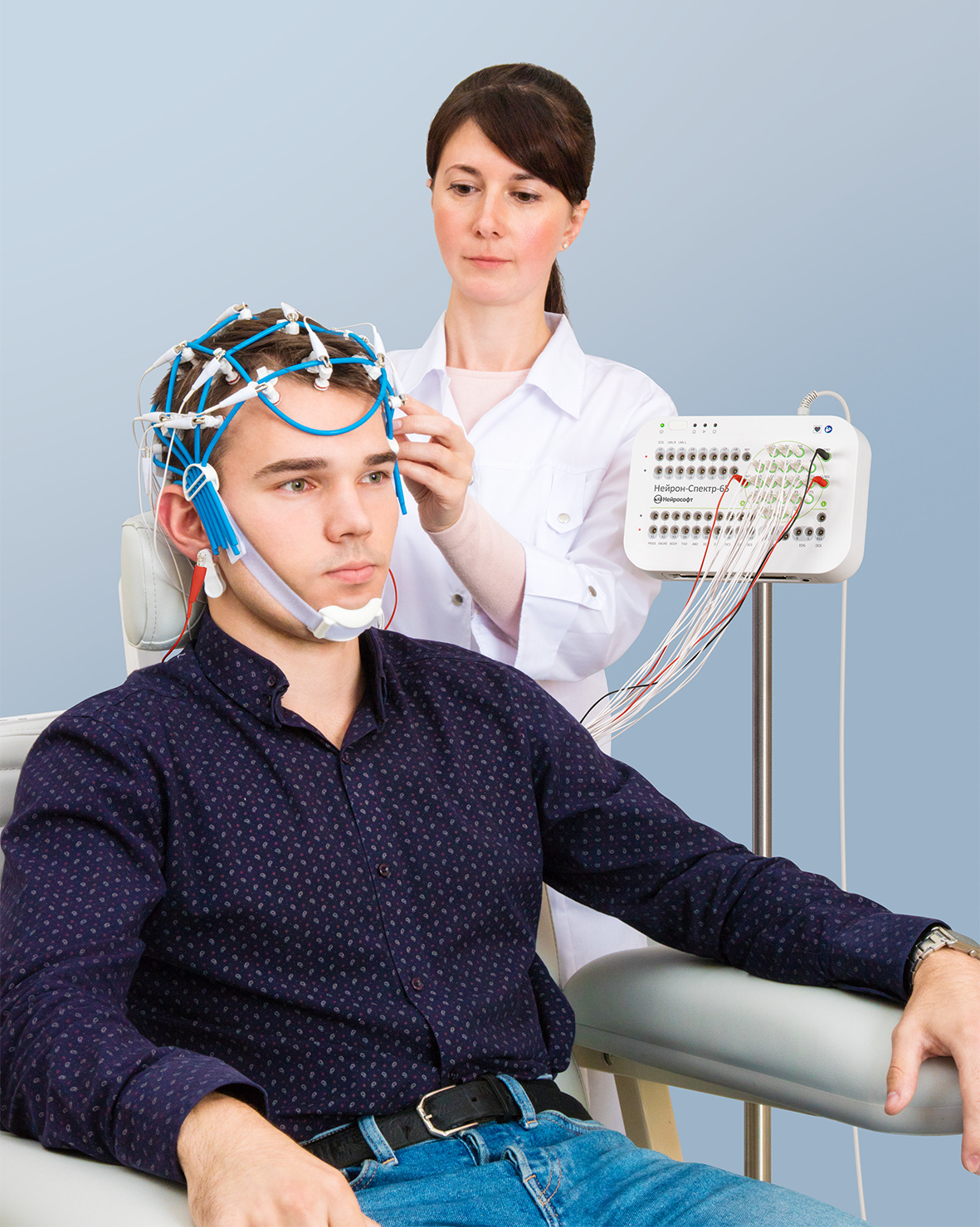
Interpreting EEG Results: Decoding Brain Wave Patterns
After your EEG test, a neurologist or epileptologist will carefully analyze the recorded brain wave patterns. This interpretation is crucial for making accurate diagnoses and treatment decisions.
How are EEG results interpreted?
EEG interpretation involves examining various aspects of the recorded brain waves, including:
- Frequency: The number of wave cycles per second
- Amplitude: The height of the waves
- Shape: The overall pattern and appearance of the waves
- Location: Which areas of the brain are producing specific wave patterns
- Symmetry: Whether wave patterns are similar on both sides of the brain
- Reactivity: How brain waves change in response to stimuli or activities
Abnormalities in these patterns can indicate various neurological conditions. For example, certain types of epileptic seizures may produce characteristic “spike and wave” patterns, while slowing of brain waves might suggest encephalopathy or dementia.

It’s important to note that EEG results are always interpreted in conjunction with a patient’s medical history, physical examination, and other diagnostic tests. A single abnormal EEG doesn’t necessarily indicate a neurological disorder, and conversely, a normal EEG doesn’t rule out all brain-related conditions.
Advances in EEG Technology: Expanding Possibilities in Neuroscience
The field of electroencephalography continues to evolve, with new technologies and applications emerging regularly. These advancements are expanding the capabilities of EEG and opening up exciting possibilities in neuroscience research and clinical practice.
What are some recent advancements in EEG technology?
Some notable developments in EEG technology include:
- High-density EEG: Using hundreds of electrodes for more detailed brain mapping
- Dry electrodes: Eliminating the need for conductive gels, making EEGs more comfortable and convenient
- Wireless EEG systems: Allowing for greater mobility during recording
- Smartphone-compatible EEG devices: Enabling at-home monitoring for certain conditions
- AI-assisted EEG interpretation: Using machine learning algorithms to improve diagnostic accuracy
- Neurofeedback: Real-time EEG monitoring for brain training and therapy
- Brain-computer interfaces: Using EEG signals to control external devices, benefiting patients with severe motor disabilities
These innovations are not only improving the diagnostic capabilities of EEG but also expanding its applications in fields such as neuromarketing, gaming, and personal health monitoring.

EEG Safety and Considerations: Addressing Common Concerns
While EEG is generally considered a safe and low-risk procedure, it’s natural to have questions or concerns about the test. Understanding the safety profile and potential considerations can help alleviate anxiety and ensure a smooth experience.
Is EEG safe for everyone?
EEG is safe for most people, including:
- Infants and children
- Pregnant women
- Elderly patients
- People with pacemakers or other implanted medical devices
However, there are a few considerations to keep in mind:
- Skin sensitivity: Some people may experience mild skin irritation from the electrode adhesive. This usually resolves quickly after the test.
- Photosensitivity: The flashing light stimulation used in some EEGs can trigger seizures in photosensitive individuals. Your technician will monitor you closely during this part of the test.
- Claustrophobia: Some people may feel uncomfortable having electrodes attached to their scalp. Communicate any concerns with your healthcare provider.
- Medication effects: Certain medications can affect EEG results. Always inform your doctor about all medications you’re taking.
- Movement artifacts: Excessive movement during the test can interfere with the recording. Try to remain as still as possible during the procedure.
If you have any specific concerns about undergoing an EEG, discuss them with your healthcare provider. They can provide personalized advice and, if necessary, make accommodations to ensure your comfort and safety during the test.

In conclusion, the electroencephalogram (EEG) stands as a cornerstone of neurological diagnostics, offering invaluable insights into brain function. From its origins in the early 20th century to the cutting-edge technologies of today, EEG continues to evolve and expand its applications in both clinical practice and scientific research. As our understanding of the brain grows, so too does the importance of this remarkable window into neural activity. Whether you’re a patient preparing for an EEG or a healthcare professional seeking to deepen your knowledge, understanding the principles, procedures, and potential of EEG is crucial in navigating the complex landscape of neurological health.
Electroencephalogram (EEG) – NHS
An electroencephalogram (EEG) is a recording of brain activity.
During this painless test, small sensors are attached to the scalp to pick up the electrical signals produced by the brain.
These signals are recorded by a machine and are looked at by a doctor.
The EEG procedure is usually carried out by a highly trained specialist, called a clinical neurophysiologist, during a short visit to hospital.
When an EEG is used
An EEG can be used to help diagnose and monitor a number of conditions affecting the brain.
It may help identify the cause of certain symptoms – such as seizures (fits) or memory problems – or find out more about a condition you’ve already been diagnosed with.
The main use of an EEG is to detect and investigate epilepsy, a condition that causes repeated seizures. An EEG will help your doctor identify the type of epilepsy you have, what may be triggering your seizures and how best to treat you.
An EEG will help your doctor identify the type of epilepsy you have, what may be triggering your seizures and how best to treat you.
Less often, an EEG may be used to investigate other problems, such as:
- dementia
- head injury and concussion
- brain tumours
- encephalitis (brain inflammation)
- sleep disorders, such as sleep apnoea.
Preparing for an EEG
Your appointment letter will mention anything you need to do to prepare for the test.
Unless told otherwise, you can usually eat and drink beforehand and continue to take all your normal medication.
To help the sensors stick to your scalp more easily, you should make sure your hair is clean and dry before arriving for your appointment, and avoid using products such as hair gel and wax.
You might want to bring a hairbrush or comb with you, as your hair may be a bit messy when the test is finished. Some people bring a hat to cover their hair until they can wash it at home afterwards.
How an EEG is carried out
There are several different ways an EEG recording can be taken. The clinical neurophysiologist will explain the procedure to you and can answer any questions you have.
You’ll also be asked whether you consent to treatment for the various parts of the test to be carried out. This may include video consent for some EEGs.
Before the test starts, your scalp will be cleaned and about 20 small sensors called electrodes will be attached using a special glue or paste. These are connected by wires to an EEG recording machine.
Sensors called electrodes are attached to the head (usually with glue or paste) and connect to an EEG recording machine. You’ll sit or lie down for an EEG.
You’ll sit or lie down for an EEG.
Credit:
Phanie / Alamy Stock Photo https://www.alamy.com/stock-photo-woman-undergoing-an-electroencephalogram-eeg-limoges-hospital-france-72431574.html?pv=1&stamp=2&imageid=7AA22C91-664F-4D38-8619-582AA92C0168&p=218158&n=0&orientation=0&pn=1&searchtype=0&IsFromSearch=1&srch=foo%3dbar%26st%3d0%26pn%3d1%26ps%3d100%26sortby%3d2%26resultview%3dsortbyPopular%26npgs%3d0%26qt%3dE5RF5X%26qt_raw%3dE5RF5X%26lic%3d3%26mr%3d0%26pr%3d0%26ot%3d0%26creative%3d%26ag%3d0%26hc%3d0%26pc%3d%26blackwhite%3d%26cutout%3d%26tbar%3d1%26et%3d0x000000000000000000000%26vp%3d0%26loc%3d0%26imgt%3d0%26dtfr%3d%26dtto%3d%26size%3d0xFF%26archive%3d1%26groupid%3d%26pseudoid%3d%7bA883FDE5-7F3D-4472-81F5-B61111916852%7d%26a%3d%26cdid%3d%26cdsrt%3d%26name%3d%26qn%3d%26apalib%3d%26apalic%3d%26lightbox%3d%26gname%3d%26gtype%3d%26xstx%3d0%26simid%3d%26saveQry%3d%26editorial%3d1%26nu%3d%26t%3d%26edoptin%3d%26customgeoip%3d%26cap%3d1%26cbstore%3d1%26vd%3d0%26lb%3d%26fi%3d2%26edrf%3d0%26ispremium%3d1%26flip%3d0%26pl%3d
Routine EEG recordings usually take 20 to 40 minutes, although a typical appointment will last about an hour, including some preparation time at the beginning and some time at the end.
Other types of EEG recording may take longer.
Types of EEG
Routine EEG
A routine EEG recording lasts for about 20 to 40 minutes.
During the test, you’ll be asked to rest quietly. You will usually be asked to open or close your eyes from time to time. In most cases, you’ll also be asked to breathe in and out deeply (called hyperventilation) for a few minutes.
A flashing light may also be used to see if this affects your brain activity.
Sleep EEG or sleep-deprived EEG
A sleep EEG is carried out while you’re asleep. It may be used if a routine EEG does not give enough information, or to test for sleep disorders.
In some cases, you may be asked to stay awake the night before the test to help ensure you can sleep while it’s carried out.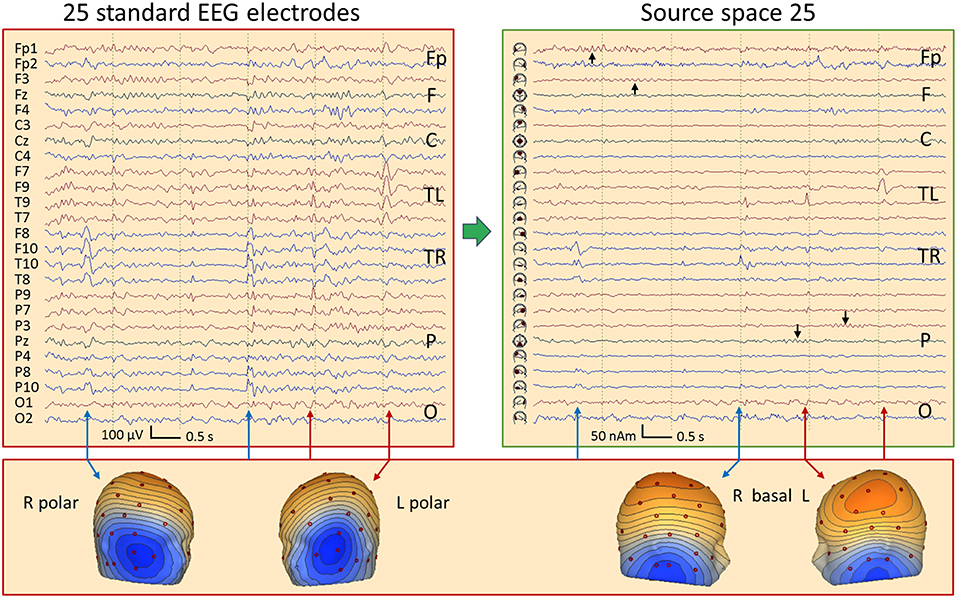 This is called a sleep-deprived EEG.
This is called a sleep-deprived EEG.
Ambulatory EEG
An ambulatory EEG is where brain activity is recorded throughout the day and night over a period of one or more days. The electrodes will be attached to a small portable EEG recorder that can be clipped onto your clothing.
You can continue with most of your normal daily activities while the recording is being taken, although you’ll need to avoid getting the equipment wet.
Video telemetry
Video telemetry, also called video EEG, is a special type of EEG where you’re filmed while an EEG recording is taken. This can help provide more information about your brain activity.
The test is usually carried out over a few days while staying in a purpose-built hospital suite.
The EEG signals are transmitted wirelessly to a computer. The video is also recorded by the computer and kept under regular surveillance by trained staff.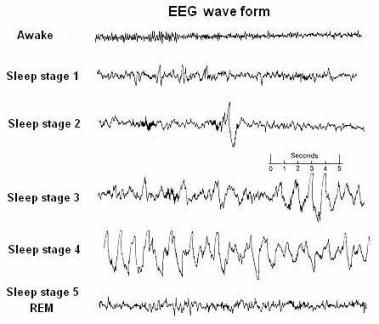
Invasive EEG-telemetry
This EEG is not common, but it may be used to check if surgery is possible for some people with more complex epilepsy.
It involves surgery to place electrodes directly on the brain to find out exactly where the seizures are coming from.
What happens after an EEG
When the test is finished, the electrodes will be removed and your scalp will be cleaned. Your hair will probably still be a bit sticky and messy afterwards, so you may want to wash it when you get home.
You can usually go home soon after the test is finished and return to your normal activities. You might feel tired after the test, particularly if you had a sleep or sleep-deprived EEG, so you may want someone to pick you up from hospital.
You normally will not get your results on the same day. The recordings will need to be analysed first and will be sent to the doctor who requested the test. They can discuss the results with you a few days or weeks later.
The recordings will need to be analysed first and will be sent to the doctor who requested the test. They can discuss the results with you a few days or weeks later.
Are there any risks or side effects?
The EEG procedure is painless, comfortable and generally very safe. No electricity is put into your body while it’s carried out. Apart from having messy hair and possibly feeling a bit tired, you normally will not experience any side effects.
However, you may feel lightheaded and notice a tingling in your lips and fingers for a few minutes during the hyperventilation part of the test. Some people develop a mild rash where the electrodes were attached.
If you have epilepsy, there’s a very small risk you could have a seizure while the test is carried out, but you’ll be closely monitored and help will be on hand in case this happens.
Video: epilepsy research – EEG
This video covers the benefits of participating in EEG research.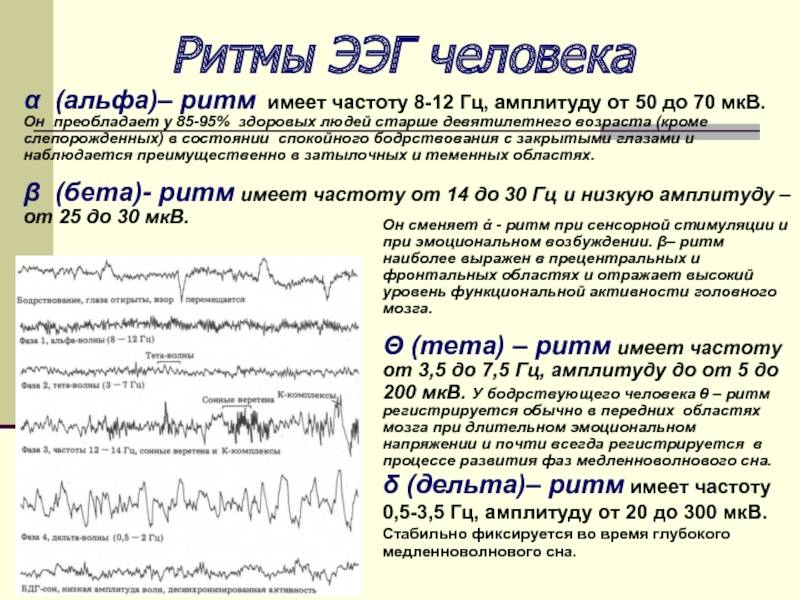
Media last reviewed: 5 August 2022
Media review due: 5 August 2025
Page last reviewed: 05 January 2022
Next review due: 05 January 2025
EEG test – Better Health Channel
The electroencephalogram (EEG) is a medical test used to measure the electrical activity of the brain, via electrodes applied to your scalp. This procedure is completely painless and can be performed without shaving any of your hair. EEG can help diagnose a number of conditions, including epilepsy, sleep disorders and brain tumours. Another name for EEG is brain wave test.
Conditions diagnosed by EEG
Normal brain waves occur at a rate of up to 30 per second, but in someone with epilepsy, for example, the EEG may show bursts of abnormal discharges in the form of spikes and sharp wave patterns. Suspected epilepsy is the most common reason for an EEG.
Other conditions that may be diagnosed with the aid of an EEG include:
- Sleep disorders (such as narcolepsy)
- Head injuries
- Brain infection
- Brain haemorrhage
- Alzheimer’s disease
- Degeneration of brain tissue
- Metabolic conditions that affect brain tissue
- Hormonal conditions that affect brain tissue
- Certain disorders of the central nervous system
- Stroke
- Brain tumour
- Brain death.

Medical issues to consider
An abnormal EEG doesn’t automatically mean that you, for example, have epilepsy. The EEGs of babies and young children can often record irregular patterns that don’t mean anything, or the irregularities may flag previously diagnosed neurological conditions such as cerebral palsy. On the other hand, a normal EEG doesn’t rule out epilepsy either. Sometimes, a person with epilepsy will only display abnormal brain waves during a seizure.
EEG procedure
Your hair must be thoroughly clean, but most importantly dry. A number of electrodes are applied to your scalp (generally between 8 and 23, depending on the condition under investigation). A gel may be applied to help the electrodes to stick firmly in place and improve recordings.
You will need to lie quietly to avoid any electrical interference from muscle contractions. Sometimes, you may be asked by the doctor to open and close your eyes and to breathe heavily. Lights may be flashed before your eyes.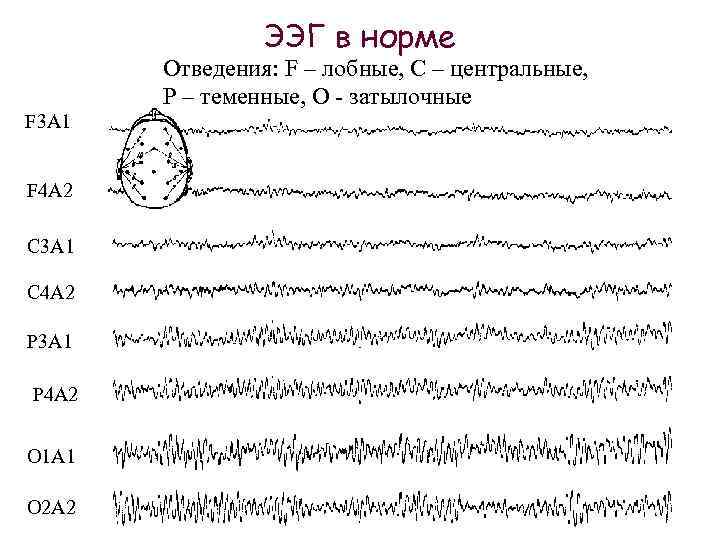 An EEG usually takes from 30 to 60 minutes to complete. Sometimes, a sleep recording is also required. If the patient is a baby or young child, it helps if the parents delay the child’s nap until the time of the EEG.
An EEG usually takes from 30 to 60 minutes to complete. Sometimes, a sleep recording is also required. If the patient is a baby or young child, it helps if the parents delay the child’s nap until the time of the EEG.
Sedatives (medications to help sleep) may be needed if sleep won’t come naturally during the test. Some EEG testing centres may record a video of your tests to help with diagnosis.
Immediately after the EEG
Once the test is complete, the electrodes are removed and you are allowed to get up. The results need to be analysed at a later stage by a neurologist (a doctor who specialises in brain disorders).
Generally, if there is no abnormality to the brain’s electrical activity, the pattern of ‘peaks and valleys’ charted by the EEG should be fairly regular. If excited, the pattern will show considerable variation, and any departure from the regular pattern can indicate abnormalities.
Complications of EEG
EEG is a safe test with no side effects. However, a person with epilepsy may experience a seizure, triggered by the various stimuli used in the procedure, including the flashing lights. (This is not seen as a ‘complication’ by medical staff, because a seizure during an EEG can greatly help in diagnosis.)
However, a person with epilepsy may experience a seizure, triggered by the various stimuli used in the procedure, including the flashing lights. (This is not seen as a ‘complication’ by medical staff, because a seizure during an EEG can greatly help in diagnosis.)
Taking care of yourself at home
EEG is a safe procedure. Be advised by your doctor, but generally, there are no special instructions for after-care. However, you will need to wash your hair thoroughly to remove all traces of gel and other fluids.
Long-term outlook
The EEG technologist can’t interpret the test results on the spot. The EEG recording must be analysed by a neurologist, who then sends the results to your doctor. It is important to make a follow-up appointment with your doctor. In many cases, the test results are sent to your doctor within 48 hours of the test. Treatment depends on the diagnosis.
Other diagnostic tests
Other diagnostic tests depend on the condition under investigation. For example, magnetic resonance imaging (MRI) scans and computed tomography (CT) scans may be used in the case of suspected brain tumour.
For example, magnetic resonance imaging (MRI) scans and computed tomography (CT) scans may be used in the case of suspected brain tumour.
Where to get help
- Your doctor
- Neurologist
Things to remember
- The electroencephalogram (EEG) is a medical test used to measure the electrical activity of the brain.
- A number of electrodes are applied to your scalp.
- EEG can help diagnose a number of conditions including epilepsy, sleep disorders and brain tumours.
Electroencephalography. Technical details
Electroencephalography (EEG) is a method of studying the brain based on recording its bioelectrical potentials. Specifically, in each channel, the potential difference between the active and reference electrodes is measured – i.e. between these electrodes flows a weak alternating electric current produced by the patient. Since the current is weak, there must be minimal resistance between the electrodes! (impedance).
With the help of EEG, it is possible to objectively study the functional state of the brain and identify the degree and localization of its damage. The method is most informative in the diagnosis of epilepsy. EEG data help to differentiate various forms of seizures, to establish the localization of the epileptic focus, as well as to monitor the effectiveness of drug therapy.
It should be remembered that the EEG records the total electrical activity from relatively large areas of the head surface. At the same time, in addition to the activity of the cerebral cortex, myographic activity of the muscles of the scalp and masticatory muscles, muscles of the eyeballs and eyelids, a rheogram and an ECG artifact can be recorded when the EEG electrode is located above the blood vessels.
So, for EEG recording, you need a number of electrodes on the head, installed at certain points, as well as a reference electrode (s) and a ground electrode.
Reference electrodes, classically located on the earlobes, designated Ref (R), but can also be placed in other places, for example, on the mastoid processes behind the ears, in the midline, between the Fz and Cz electrodes (electrodes located in the midline , are denoted by the index – “z”, from “zero”, i. e. Zero). Electrodes that are located in the left hemisphere are usually denoted by odd numbers, and those in the right hemisphere by even numbers. It is obligatory to have a ground electrode, which can be located anywhere on the head (most often it is installed between the Fp1 and Fp2 electrodes on the forehead, at the point Fpz).
e. Zero). Electrodes that are located in the left hemisphere are usually denoted by odd numbers, and those in the right hemisphere by even numbers. It is obligatory to have a ground electrode, which can be located anywhere on the head (most often it is installed between the Fp1 and Fp2 electrodes on the forehead, at the point Fpz).
A complete 10-20 standard circuit provides 21 electrodes (including 1 ground electrode and 1 reference).
The locations of the electrical activity of the brain are marked with letters, in accordance with the areas over which the electrodes are located:
0003
Frontal – F (frontalis)
Temporal – T (temporalis)
International electrode layout.
The International 10-20% Scheme, or simply the 10-20 Scheme, was developed by Jasper H. in 1958 to standardize terminology and describe the location of scalp electrodes so that EEG recordings can be comparable, regardless of the laboratory and physician analyzing the study .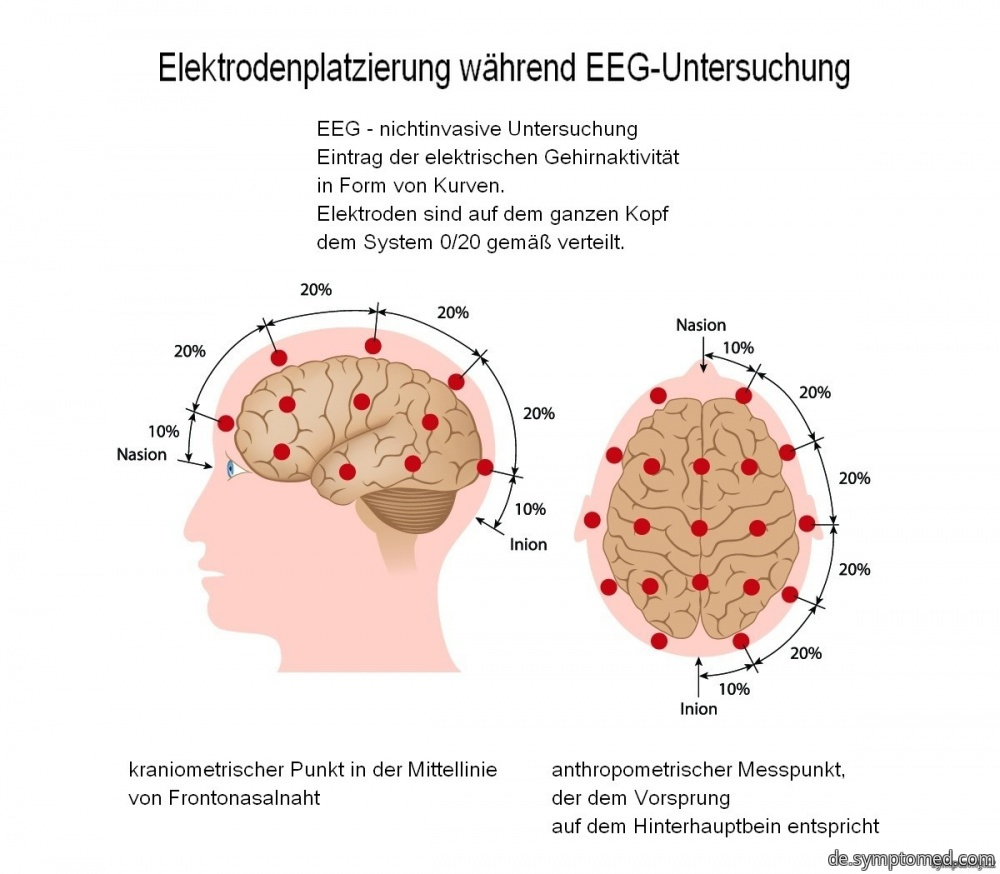 It is currently the international standard for electrode placement. It is used when sticking collodion electrodes, as well as in EEG caps, which appeared much later.
It is currently the international standard for electrode placement. It is used when sticking collodion electrodes, as well as in EEG caps, which appeared much later.
This scheme involves measuring the distance from the bony landmarks of the skull, followed by the calculation of the intervals between the electrodes in percent, to determine the location of the electrodes. The principle is as follows:
1) The distance between the points Nasion (bridge of the nose) and Inion (protrusion of the occiput) is measured.
At 10% of the obtained distance, above the occiput, there is a point Oz and a line of occipital electrodes (O1, O2). Anterior to this line, at a distance of 20% is the point Pz and the line of the parietal electrodes (P3, P4), after another 20% – the point Cz and the line of the central electrodes (C3, C4), and after another 20% – the point Fz and the line of the frontal electrodes (F3, F4). The frontal pole electrodes (Fp1 and Fp2) are located on a line 10% above the Nasion point and 20% from the line of the forehead electrodes.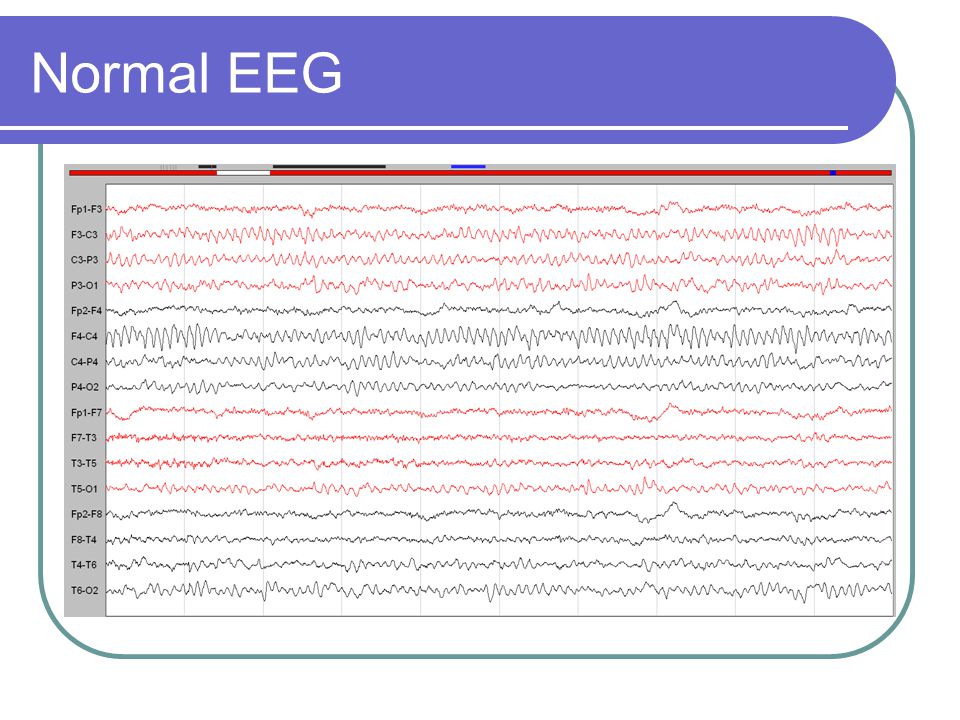 At the point of intersection of this line with the longitudinal one, there is a point Fpz.
At the point of intersection of this line with the longitudinal one, there is a point Fpz.
2) The second main distance is measured between the parotid points (the indentation immediately above the tragus is taken as a reference), along a line that passes through the middle of the first distance. It is also divided into segments as a percentage: 10% above the ear canals, on each side, are the temporal electrodes (T3 and T4), 20% above the temporal electrodes are the aforementioned central electrodes (C3, C4).
3) The third distance is measured as the circumference of the head, however, the tape is laid strictly through the already found points Fpz, T3, Oz and T4 (along the circumference). Half of the distance obtained is taken as 100% and, based on this, 10% to the left and right of Fpz are calculated to determine the pole frontal electrodes (Fp1 and Fp2, respectively) and 10% of Oz, to determine the occipital electrodes (O1 and O2) . Also on this line are:
– lower frontal electrodes (F7 and F8), at a distance of 20% from Fp1 (posteriorly) and T3 (anteriorly) and similarly on the other side.
– posterior temporal electrodes (T5 and T6), at a distance of 20% from T3 (posteriorly) and O1 (anteriorly) and similarly on the other side.
As already mentioned, sagittal electrodes are placed along the midline – frontal (Fz), central (Cz), parietal (Pz). Points Fpz and Oz are not used to install active electrodes in the 10-20 system.
By the size of segments of 10 and 20%, this scheme got its name.
Marking the head for installing collodion electrodes:
1. Laying the measuring tape from Nasion to Inion strictly along the midline, we measure the first distance, and on its half, to the right and left of the tape, we put intermediate marks.
2. Measure the distance between the parotid points, laying the edge of the tape through the above intermediate marks.
In the middle of this distance there will be a confirmed point Cz. Without releasing the tape, you can mark points T3, T4, C3 and C4,
Example: We got 35 cm. 10% of 35 = 3.5 cm.
10% of 35 = 3.5 cm.
From each round point, along the same line, we measure up 3.5 cm to the right and left – we find points T3 and T4.
Divide the distance from T3 to Cz in half, find C3
Divide the distance from T4 to Cz in half, find C4
3. Lay the tape again between the points Nasion and Inion, but this time laying the edge of the tape through the already confirmed
point Cz.
Example: 40 cm specified distance. 10% of 40 = 4 cm. So, from Nasion and Inion we measure 4 cm up along the midline and mark the conditional points Fpz and Oz.
We divide in half the distance from the point Cz and the point Oz, we get the point Pz. Similarly, we divide in half the distance from the point Cz to the point Fpz and find the point Fz.
4. As mentioned above, we measure the circumference of the head strictly through the already found points Fpz, T3, Oz and T4 (along the circumference). Half of the obtained distance is taken as 100%. Based on this, 10% to the left and right of Fpz ( along this circle ) are calculated to determine the pole frontal electrodes (Fp1 and Fp2, respectively) and 10% of Oz, to determine the occipital electrodes (O1 and O2).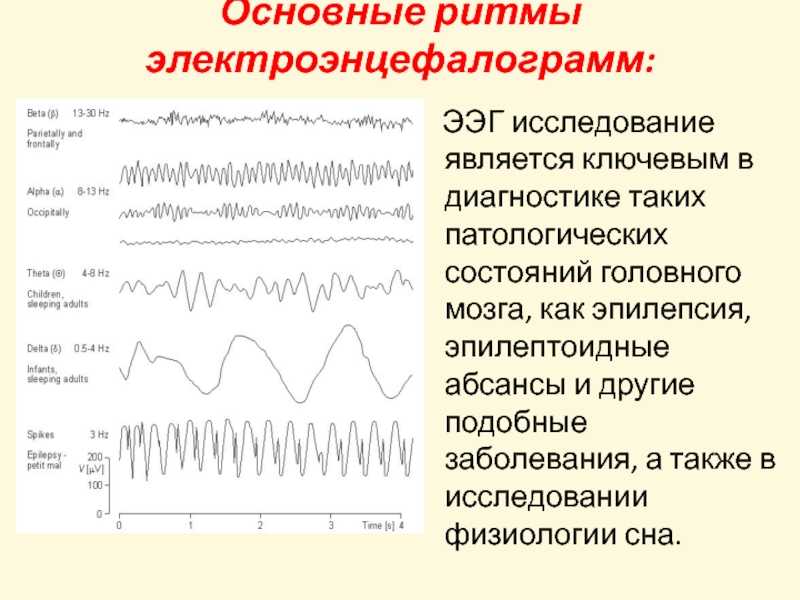
Example: head circumference of 60 cm is 200%. Half of this = 30 cm. 10% of 30 = 3 cm.
5. Find F7 and F8; T5 and T6.
Divide the distance from Fp1 to T3 in half, find F7
Divide the distance from Fp2 to T4 in half, find F8
and
Divide the distance from T3 to O1 in half, find T5
Divide the distance from T4 to O2 in half, find T6
90 002 Test yourself: the above points should lie on your measured head circumference.
6. Find F3 and F4; P3 and P4.
If you lay the measuring tape in an arc through the points Fp1-C3-O1, you will get a “parallel” (see fig. 1), which intersects with the “meridian” going through the points F7-Fz-F8 (see fig. 2) at point F3 .
Similarly, the “parallel” Fp2-C4-O2 intersects with the same “meredian” at the point F4 .
1 Fig. 2 Fig. 3
3
In the same way, by laying the “meridian” through the points T5-Pz-T6 (see Fig. 3), you can calculate the points P3 and P4 .
In other words, point F3 is halfway between points Fp1-C3 and Fz-F7.
Similarly, point F4 is halfway between points Fp2-C4 and Fz-F8.
Same with electrodes P3 and P4.
In practice, in addition to the electrodes installed according to the 10-20 system, additional electrodes are used to locate which the same principle is used. We are talking about the electrodes of the zygomatic arch (F9, F10, T9, T10, P9 and P10). How to locate them?
Remember the distance measured from the parotid points through Cz. Each of the listed electrodes is 10% lower than the corresponding electrodes lying on the circumference of the head:
– F9 and F10 are 10% lower than the F7 and F8 electrodes, respectively. That is, they lie on the zygomatic bone.
– T9 and T10 are 10% lower than the T3 and T4 electrodes, respectively. In fact, they lie on the parotid points.
In fact, they lie on the parotid points.
– P9 and P10 are 10% lower than the electrodes T5 and T6, respectively. They lie on the mastoid processes of the skull (mastoideus).
The use of these electrodes can help localize interictal epileptiform activity and the EEG onset. In particular, anterior zygomatic electrodes, according to some authors, are non-invasive analogues of sphenoidal electrodes.
Mountings.
Recorded EEG data can be presented in different ways. For this, there are various wiring diagrams.
The most common way to monitor a recording is to use referential editing – this is how the amplifier perceives the data.
All other montages are reconstructions resulting from potential difference mathematical calculations based on reference montage data.
Features of wiring diagrams (from the point of view of a technician) :
– in referential installation it is convenient to control the quality of electrode application, judging by the interference in one or another lead.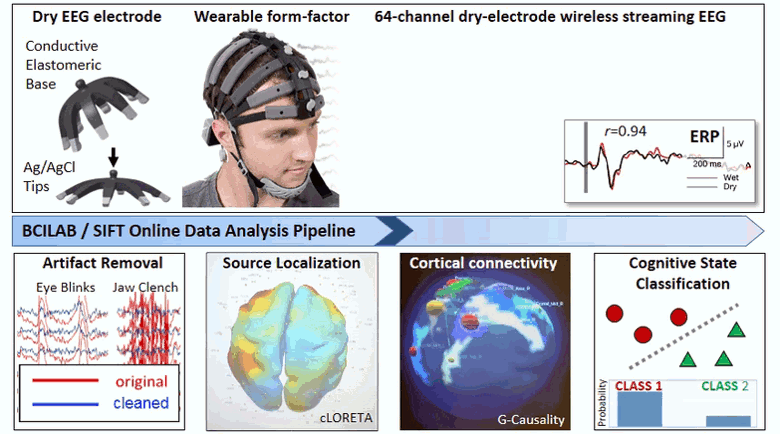
– in bipolar mounting (longitudinal chain) so-called. “drenched electrodes” – i.e. electrodes, between which a path of electrically conductive gel was formed, therefore, they became a single electrode, inside which there is no potential difference, just as there is no potential difference between the different ends of the nail. On the EEG, in this case, in the lead, consisting of a pair of “filled” electrodes (for example, F3-C3), an isoline is recorded.
– transverse mounting. In fact – the same bipolar installation, only the chains of leads go in the transverse direction. Similarly, in a flooded pair of electrodes (for example, F7-F3), an isoline will be recorded. The peculiarity is that if you have F7-F3 filled in, then everything will be fine in the bipolar (previous) installation! (but the EEG data is incorrect).
Prepared by: EEG assistant Kozlova M.A. and head. laboratory of video-EEG monitoring Troitsky A.A.
Electroencephalography (EEG)
January 21, 2016
A complete and high-quality diagnosis of disorders that occur in the brain and have a psychoneurological nature is impossible without the use of hardware research methods, the main of which is EEG (electroencephalography).
Essence of the method
This method of examining brain activity is based on a comprehensive and in-depth analysis of electrical impulses that are generated by groups of neurons. These weak electrical discharges are captured using a group of electrodes fixed on the head of the person being examined, and after the necessary amplification, they are displayed on the electroencephalograph monitor. To save the data on the survey, information about it is recorded in the computer’s memory or visualized in the form of a graph on a paper tape, which is called an electroencephalogram of the brain.
Identifiable brain abnormalities
Electrical impulses generated by neurons have a certain frequency and amplitude. Depending on the psycho-emotional state of a person, these indicators may vary. Therefore, having studied a person’s electroencephalogram, specialists from a self-supporting polyclinic located at the “Youth Library” can find out the state of his brain, both in general and in certain departments.
Depending on the psycho-emotional state of a person, these indicators may vary. Therefore, having studied a person’s electroencephalogram, specialists from a self-supporting polyclinic located at the “Youth Library” can find out the state of his brain, both in general and in certain departments.
Deciphering the results of the EEG of the brain makes it possible to identify:
– benign or malignant tumors;
– insufficient level of blood supply to the brain;
– pathological deviations in the work of the central nervous system, provoked by infectious diseases;
– epilepsy;
– developing neuroses of any etiology;
– the presence of deviations in mental development.
An analysis of the EEG of the brain allows the attending physician not only to clarify the final diagnosis, but also to identify positive changes in the patient’s condition, and also to carry out the necessary adjustment of the drugs used during the treatment.
Preparing and conducting a survey
In order for the data obtained during the examination to be reliable, before passing the EEG, it is necessary:
– exclude from the diet foods that stimulate the central nervous system;
– wash your hair well to remove the remnants of hair care products;
– eat well.
During the examination, the patient lies down on a couch or sits down in a chair, after which a special cap is put on his head, to which electrodes are attached in certain places. Now the person undergoing the examination needs to relax as much as possible and wait for the end of the procedure, which can last up to two hours.
Often, electroencephalography is accompanied by sound or light signals given in a chaotic manner. This is done to enhance the information content of the electroencephalogram or to identify some difficult-to-diagnose diseases. Sometimes it is required to determine the activity of the brain excited by an excess of oxygen.

